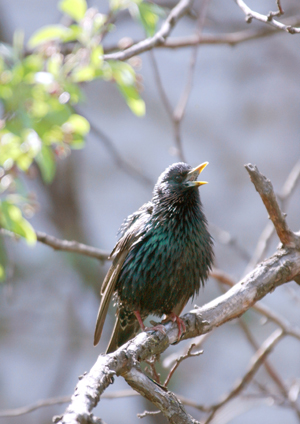 |
|
|||||||||
|
Chicago researchers are peering inside the minds of European starlings to learn how they recognize songs—and in the process are providing insights into how the brain learns, recognizes, and remembers complex sounds at the cellular level. In the August 7 Nature Timothy Gentner, organismal biology & anatomy research associate, and Daniel Margoliash, professor of organismal biology & anatomy and psychology, show how songs that birds have learned to recognize trigger responses both in individual neurons and in groups of neurons in the birds’ brains.
“We found that cells in a part of the brain are altered dramatically by the learning process,” Margoliash says. “As birds learn to recognize certain songs, the cells in this area”—the cmHV, analogous to the higher-order, secondary auditory cortex in humans—“become sensitive to particular sound patterns or auditory objects that occur in the learned songs, while cells never show such sensitivity to patterns in unfamiliar songs. Specific cells in the brain become ‘tuned’ to what the bird is learning.” How the brain perceives and interprets stimuli from the external world are fundamental neuroscience questions. Memories of words, sounds of voices, or patterns of music are important components of human daily experience and are essential for much communication, yet, Margoliash says, “we know little about how such memories are formed in the brain and how they are retrieved.” Bird songs have captured human interest for ages. As Margoliash notes, “Birders can often recognize many species of birds by only their songs.” For birds, however, the ability to match a singer to a song—often down to the level of an individual bird—can mean the difference between “a day spent wrestling through the thicket and one spent enjoying a sun-soaked perch,” Margoliash says, “or the missed chance at mating with the healthiest partner around.” Gentner, the study’s lead investigator, has tapped into starlings’ recognition abilities by training about 30 birds to identify songs. The birds, brought from the wild to the lab as adults, were taught to peck different buttons on a small metal panel to indicate specific starling tunes from computer recordings. The researchers rewarded correct responses with food and conveyed incorrect responses by turning off the lights. Gentner's earlier research has shown that European starlings learn to recognize different songs by the individual pieces that comprise each tune. “If you listen closely to a singing starling,” Gentner says, “you'll hear that the song is really composed of much shorter sounds. We call these sounds ‘motifs,’ and to produce a song the bird will sing the same motif a few times, then switch to a new repeated motif, and then another, as long as he can keep it going. When male starlings sing, they might use only half of the motifs they know and then mix up the motifs when they sing another song.” Given this highly variable structure, when other
starlings learn which songs belong to which individuals, they do
so by concentrating on the motifs. “Even one or two familiar
motifs in an otherwise unfamiliar song,” Gentner says, “is
enough to trigger recognition.” As a group the cells responded much more strongly to the songs the birds had learned to recognize than to the other sounds. Individually most cells responded to only one song, and almost all (93 percent) of these cells responded to a song the bird had learned to recognize. After examining the data even closer, the researchers found that many of these cells responded only to specific motifs within the song. “The song motifs that drive these cells so strongly are the same components of sounds that control recognition behavior in the birds,” Gentner explains. “It appears that we are seeing the memory traces for recognition of these complex acoustic patterns. Rather than representing all motifs equally well at any time, we find that experience modifies the brain to highlight those motifs that are the most important to the bird at that time.” Why specific motifs are critical at a certain time is still unknown, and a question Gentner plans to study. He and Margoliash also plan to look deeper into starlings’ capacity for memory. “Memories are not permanent," Margoliash notes. “Do we lose memories because of disuse or because they are crowded out by other memories? Our research shows that the context in which you learn a sound affects how it is memorized. What are the brain mechanisms that control this process of how a memory is laid down?"—Catherine Gianaro
|
|
Contact
|


